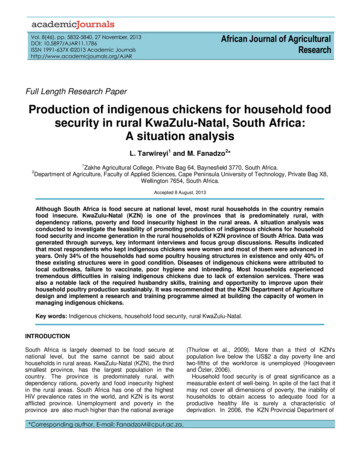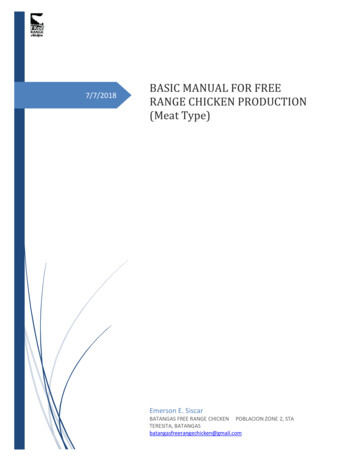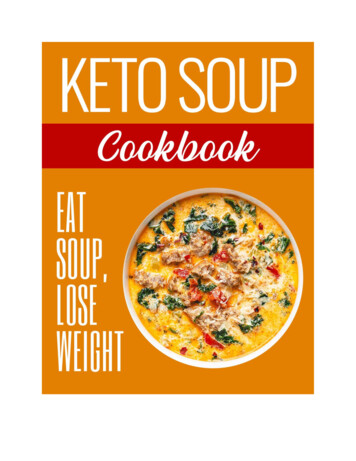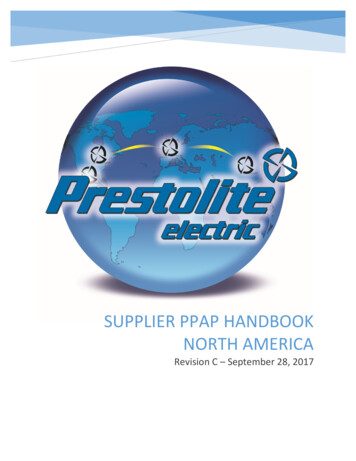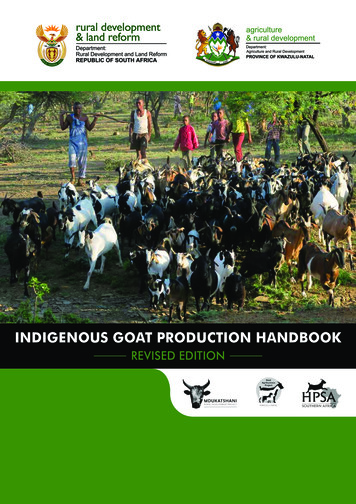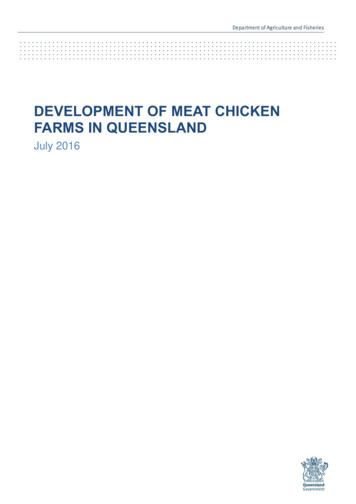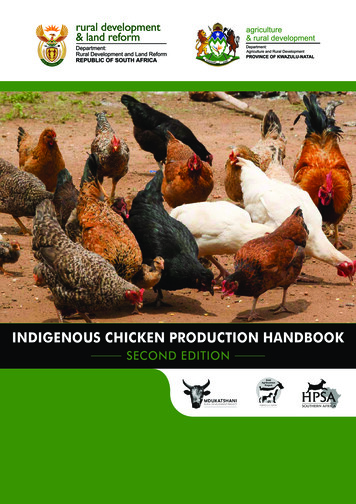
Transcription
INDIGENOUS CHICKEN PRODUCTION HANDBOOKSECOND EDITION
Indigenous Chicken Production HandbookSecond Edition 2019ISBN 978-1-928310-25-9Prepared by:Mdukatshani, HPSA, Department of Rural Development and Land Reform (DRDLR) and KwaZulu-Natal,Department of Agriculture and Rural Development (DARD)Contributors:Rauri Alcock, Hannes de Villiers, Trevor Dugmore, Francois du Toit, Marisia Geraci, Sibongiseni Gcumisa,Sibusiso Gumede, Brigid Letty, Gugu Mbatha, Dumisani Mtshali, Keith Perrett, Alan Rowe, Ed Whetley,Harry Swartson, Nomfuzo Mkhize, MSDThanks to the communities involved in the GAP program for their support, time, innovations and ideas.Design and layout: Tangerine DesignPictures: Imbuzi Imali, Flickr and MSD
INDIGENOUSCHICKEN PRODUCTION HANDBOOKSECOND EDITIONProduced by:Mdukatshani, HPSA, Department of Rural Development and Land Reform (DRDLR) andKwaZulu-Natal Department of Agriculture and Rural Development (DARD)
2Indigenous Chicken Production Handbook
ContentsHow to use this book.5Part 1: Basics of keeping chickens .71.2.3.4.5.Breed.81.1A healthy chicken. 81.2Chicken breeds . 81.3Basic information on indigenous chickens .11Nutrition and stress. 122.1Why is nutrition important? .122.2Stress and Immunity .122.3Why is food important? .132.4Feeds, feeding and nutrition .13Management and identification. 153.1Catching and handling chickens properly .153.2Collecting eggs .153.3Identification systems .15Protection and vaccination . 164.1Reasons for confining household chickens .164.2Nesting and housing options .174.3Health interventions .184.4Chicken 11-point check.20Treatment. 215.1Good hygiene practices.215.2Basic vet kit and medicines .215.3Storage.225.4Cold chains.23Indigenous Chicken Production Handbook3
Part 2: Diseases, parasites and problematic conditions . 256.7.8.9.Diseases. 266.1Newcastle Disease (Paramyxovirus) .266.2Fowlpox.286.3Coccidiosis .296.4Fowl Cholera .296.5Gumboro.306.6Bumblefoot .31Internal parasites. 327.1Roundworm.327.2Tapeworm .33External parasites. 348.1Scaly leg mites (Knemidocoptes mutans) .348.2Chicken mites (Dermanyssus gallinae).348.3Tampan Fowl ticks (Argus persicus).358.4Avain Lice (Menopon gallinae).36Eating Disorders . 379.1Cannabilism .379.2Egg eating.38Part 3: Marketing and management decisions. 39410.Marketing and management decisions . 4011.Managing the flock numbers . 4012.Producing a more marketable chicken . 4013.Improving egg and chick production . 4114.Record-keeping . 43Indigenous Chicken Production Handbook
How to use this bookThe aim of this book is to assist owners of indigenous chickens using extensive farming systems.It looks at ways to improve the productivity of their flock. It is designed to be shared withfarmers in a way that allows them to understand how to find their way through the book and howto find the information that they need. It is best if the book is used as part of a capacity buildingprogramme being implemented by extension officers and field workers.Part 1: Basics of keeping chickens:This section covers everything a communal chicken farmer needs to keep their indigenous flockhealthy and productive within its current limits. This part of the book follows these five steps to ahealthy chicken:1. Breed5. Treatment4. Protection andvaccination2. Nutritionand stress3. Managementand identification1. Breed – choosing a breed that is relevant to your farming system and conditions is the best wayof having a productive, efficient and healthy flock (page 8-11).2. Nutrition and stress – malnutrition, bad nutrition and stress will reduce productivity and increase vulnerability to diseases, problematic conditions and parasites (page 12-14).3. Management and identification – good management practices will reduce or prevent diseases, conditions and parasites. This is the most cost-effective way to prevent these diseases orparasites. The biggest perceived losses that farmers report occur through birds being stolen orgetting lost so systems to reduce this through proper identification systems is crucial for a farmer(pages 15-17).Indigenous Chicken Production Handbook5
4. Protection and vaccination – giving a chicken shelter can prevent disease and stress. Farmersneed to be able to able to identify symptoms of diseases, problematic conditions and parasitesand understand how to best prevent these problems before they start or spread. Vaccination isonly possible for certain diseases (pages 17-19).5. Treatment – once a chicken is sick, treating the problem quickly is important. Giving the rightdose and the correct type of treatment is equally important (pages 20-23).Part 2: Common diseases, conditions and parasites:A section on common diseases, problematic conditions and parasites that affect chickens is onpages 26-38. This details management, prevention and treatment options where possible foreach one.Paart 3: Management and marketing decisions:This section is for farmers who increase their flock productivity will notice a rapid increase in flocksize which needs to be managed. Although more chickens seem like a good idea, the increase infeeding and other management costs needs to be kept under control. This section also looks atmarketing and management options linked to these increases.There are further training materials to support training farmers with this book. They are availableat www.mdukatshani.com, www.hpsa.org.za or www.gapkzn.co.za. These are training modules linked to sections in the book and can be downloaded as pdfs for printing, or as PowerPointpresentations. These training materials reference this book’s sections and pages.This book is not for sale but is distributed as part of a training programme.It is available as a free download in isiZulu or English, from the websiteslisted above and it is copyrighted to Imbuzi Imali.6Indigenous Chicken Production Handbook
Part1: Basics of keeping chickensPART 1Basics of keepingchickensIndigenous Chicken Production Handbook7
Part1: Basics of keeping chickens1. BreedIdentifying what a healthy chicken would look like and behave like will help understand any of thefollowing interventions.1.1 A healthy chickenyy It has a pink combyy It walks without limpingyy Its feathers are sleekyy It doesn’t have dirty feathersyy The scales on its feet are smooth and yellowyy It does not have diarrhoeayy Its feathers are smooth and shinyyy The bones are not sticking out on the breast.Chicken breeds1.2 Chicken breedsA local breed has the best chance of resistance and adaptability to the diseases and the food sourcesof the area, selecting a local breed is always the best place to start a healthy flock. There are manyChicken types, most adapted and bred for particular needs. The indigenous breed is a generalisedland race that has adapted to local conditions. These can vary a lot in size colours and looks.A healthy animal is more able to resist diseases and can recover more easily when it does get sick. Asick animal costs a farmer money and time. A farmer with a sick animal has to buy medicines,syringesand needles. It is therefore better for a farmer if animals stay healthy and do not get sick. So beforewe consider how to treat diseases, it is best to think about how to recognize healthy animals and howto keep them healthy.8Indigenous Chicken Production Handbook
Part1: Basics of keeping chickensTreatment is also more successful if it is given early, before the animal is so sick that the medicine canhelp it. This means that a farmer must be able to tell very quickly if he or she has a sick animal, whatsickness it has and what he or she can do about it.1.2.1 Indigenous chickensyy Many colours, shapes and sizes – some with bare necks.yy Tougher meat from outdoor lifestyle and dietyy Can live off the land by scavenging, so low costyy They are ‘smart’ and sleep off the ground, are good runners and can fly when they need to, thusavoiding predatorsyy They find/make nests and brood wellyy They can be hard to control/catch/handleThey are not as efficient at putting on weight as exotic or commercial breeds and do not lay all yearround, even when fed expensive high protein feed. They can be selectively bred for certain colourwhich makes them suitable for specific traditional purposes and sacrifice ceremonies.1.2.2 Improved indigenous breedsThey have been selectively bred to be better than (for example the Potchefstroom Koekoek) indigenous chickens interms of growth rates and laying potential. They need morecare and feeding than unimproved local chickens and cannotscavenge as well.Many farmers express interest in increasing their perceivedflock weaknesses (often related to size, growth or egg production) by cross breeding with exotic breeds. There are bothadvantages and disadvantages of trying this, but generallyit can bring weakness into an indigenous flock and createproblems that farmers had not thought through in terms ofincreased vulnerability to disease and stresses.Indigenous Chicken Production Handbook9
Part1: Basics of keeping chickens1.2.3 Exotic/introduced breeds (for exampleBlack Australorps)These are generally birds bred in Europe or the UK and they arenot well adapted to local conditions, especially our rural areas.There are many different types of chickens that have been bredfor different purposes. Black Australorps are kept for meat, whileLeghorns are kept for eggs. Some breeds are called dual purpose– they have been bred for meat and egg production.1.2.4 Commercial hybrid layersThese are chickens that have been specially bred to produce eggs and they are normally kept incages or in sheds. You cannot breed your own replacements – you have to buy new ‘point of laypullets’ from a proper supplier when your hens get old. These hens can lay almost continuously formore than a year (almost one egg per day for a year). They need a lot of expensive high protein food(special layer diet) to lay eggs like this. If they are not kept in cages and are allowed to free-range,they sometimes lay eggs on the ground and they do not always return to the same nest.Commercial layers are normally debeaked (the tip of their beak is removed)on hatching so they are not good atscavenging outdoors and cannot compete with other chickens. They havebeen bred not to become broody sothat they will continue to lay eggs. Thisalso means that they will not be goodmothers. They are more easily handled,cannot fly as well as local householdchickens and often roost on the groundat night. This also makes them very vulnerable to predators.1.2.5 Commercial hybridbroilersBroilers have been bred specifically formeat production. They grow very fastand can be sold at 6 weeks of age forslaughter. They need to be fed a properbroiler ration for the full 6 weeks (asmuch as they can eat). Broilers get tooheavy if they are kept for much longerthan 6 weeks and they develop legproblems. They cannot scavenge andmust be provided with all their food.10Indigenous Chicken Production Handbook
Part1: Basics of keeping chickens1.3 Basic information on indigenous chickensSome key characteristics of household chickens and their production systems are:yy They are usually ‘indigenous’ or ‘local’ stock.yy They are raised in small numbers (flocks of 1-50) but commonly flocks consist of 5-15 chickens.yy They are generally not confined and scavenge for most of their food.yy They are usually only fed household food scraps or maize/sorghum.yy They require minimal veterinary inputs.yy They mainly use family labour and are usually cared for by women and children.yy Production is geared mainly towards home consumption and savings (they provide a livingbank) and for small expenses such as school fees.yy Hens normally start to lay eggs at 24-30 weeks (6-7.5 months) of age. At any given time onlyhalf of the hens are productive and 8-10% never lay.yy Most birds produce 2-4 clutches of eggs a year, which they brood. There are on average 10-12eggs per clutch.yy A hen will lay for about 12-20 days until she has a full clutch of eggs and will then start brooding. She will incubate (brood) the eggs for 21 days and the chicks will then emerge (hatch).yy 70-90% eggs will hatch varying with the season.yy The chicks will stay with their mother for about 2 months but the hen will not start laying againfor some 4-6 months after the previous clutch.yy Only 20-50% chicks reach adulthood (and 85% of mortalities occur in the first 3 weeks of age).Adapted from: Ahlers et al. 2009Indigenous Chicken Production Handbook11
Part1: Basics of keeping chickens2. Nutrition and stress2.1 Why is nutrition important?If chickens are put in cages or houses, they will not be able to scavenge for the nutrients that theyneed. Feeding them crushed maize alone will not be enough and they will be unproductive andmay even die. Chicks will grow very slowly and will be susceptible to disease. THIS IS WHY IT ISIMPORTANT TO SUPPLEMENT CHICKENS – ESPECIALLY IF THEY ARE CONFINED!2.1.1 How do you recognise nutritional problems?Where the chickens have nutrient deficiencies, the farmers will notice that their chickens’ feathers arelooking untidy and not smooth. They hang their wings and are listless. They will often start cannibalizing each other. Normally this starts with them pecking feathers of other birds and then pecking atthe wounds that form.Hens with calcium deficiencies will sometimes start eating eggs and may eat old shells that are leftin nests after hatching. Feeding boiled eggshells to hens can help prevent egg eating behaviour (seepage 37).A condition called hard tongue is often experienced by farmers of extensive systems where a hardsheath develops over the tongue from the chicken eating rough grass and plants while it is foraging.This is not life threatening but does seem to reduce the chickens ability to eat efficiently. Most farmers pull this sheath off which seems to solve the problem.2.2 Stress and ImmunityThe immune system keeps the animal healthy. All animals and people have immune systems. Thejob of the immune system is to fight germs that invade the animal and could cause it to get sick. Theimmune system is like the animal’s own army, ready at all times to fight invaders that put the animal’slife at risk.The immune system is found everywhere in the animal’s body. It is made up of millions of little cellsthat are too small for people to see with their eyes. When germs enter the animal’s body, these immune cells come from all over to attack the germs. If the cells win the battle, the animal stays healthy.If they lose the battle, the animal may get sick and need treatment. The cells are produced in thebone marrow and then spread around the body in the blood.The immune system can recognise diseases if it has fought these diseases before. With some diseases,this recognition lasts the animal’s whole life. With other diseases, however, the immune system canrecognise the disease when it is present often but stops being able to recognise it when the animalhasn’t had it for a long time.12Indigenous Chicken Production Handbook
Part1: Basics of keeping chickens2.2.1 What commonly causes stressStress can lower immunity and thus allow diseases and parasites to infect or affect the goat’s health.Stress can be caused by many factors:yy Hungeryy Change in dietyy Thirstyy Cold (exposure to windand rain or sleeping ina dirty pen)yy Egg layingyy Broodingyy Change in environmentyy Tiredness (walkinglong distances)2.3 Why is food important?No matter how good your animal’s immune system, if it is constantly hungry and malnourished, it willeventually become sick. This is because a malnourished animal’s immune system cannot successfullyfight all the different diseases trying to attack it. One or more of these diseases will eventually defeatthe immune system of the hungry animal, making it weaker and more susceptible to all the otherdiseases waiting to attack.It is better to have a well-fed animal so that it is generally in good condition. If it gets sick, such ananimal is more likely to recover from illness than a hungry, thin one. A well-fed animal that gets sickcan sometimes recover by itself without treatment.It is therefore important that animals have enough good quality food so that they are able to main tain their immune system and to fight disease. A well-fed animal is usually a healthy animal with astrong immune system. In winter when there is not enough good quality food, animals can get sickvery easily2.4 Feeds, feeding and nutritionWhen chickens are not able to find enough food, they will not grow properly and their egg production will also drop. They will also become susceptible to diseases and parasites.Protein sources for chickens that will benefit productivityIndigenous Chicken Production Handbook13
Part1: Basics of keeping chickens2.4.1 Essential nutrientsThe following five elements of a good diet are essential to life, growth, production and reproductionin all types of poultry. With chickens that are free to scavenge, nature supplies most of these essentials in the form of grass and leafy plants, insects and other small animals such as worms, gravel,grains, seeds and sunshine, etc. You need to make sure that your chickens have access to differentfeedstuffs that provide sufficient amounts of these five elements of a good diet.yy Water – Chickens can live longer without food than without water. Growth of young chickensas well as egg production of hens will decline if they are not provided with a continuous supplyof clean water.yy Protein – This is usually the most expensive feed material, but the one most likely to bringprofitable results if properly used because the diets of scavenging chickens often do not haveenough protein for chicks and growers.yy Protein from animal sources – milk, liver, fish scraps, eggs, meat or meat meal – is moreeffective in promoting growth and egg production, than protein from most vegetable sources.Grains alone are entirely inadequate in amount and kind of protein. Growth and survival ratesof chicks are greatly improved if they are given preferential access to household scraps supplemented with protein.yy Carbohydrates – These are the starchy materials found in grains and grain products such asmaize meal. They supply energy to the chickens and the excess forms fat in the body or the egg.yy Minerals – Calcium carbonate (from limestone, gravel, snail shells, bone, etc.), in the presenceof Vitamin D, forms most of the eggshell. Bone contains mostly calcium and phosphorous. Saltsupplies some essential minerals. Green feed contains small amounts of certain highly important minerals. You can also dry eggshells in an oven or over an open fire and crush them andfeed them back to your hens. The drying process removes all egg content and ensures that theydo not start eating their own eggs.yy Vitamins – These occur naturally in fresh foods, especially vegetables and leafy plants, or can beadded as a supplement. They keep your chickens’ immune systems healthy.Different sources of carbohydrates14Indigenous Chicken Production Handbook
Part1: Basics of keeping chickens3. Management and identification3.1 Catching and handling chickens properlyIt is important that the handling of chickens is done well. Wrong handling will cause the chicken tobecome stressed. Stressed chickens are more vulnerable to diseases and might even stop laying.Don’t make suddenmovements or loudnoises. It’s best ifyou catch a chickenat dusk or while youare feeding them.Hold the chicken byits legs and neverhold it by its neck,wings or tail. Holdthe chicken withyour hand under itsbreast and hold thebody against you toprevent flapping.3.2 Collecting eggsWhen collecting eggs from a chicken, a farmer needs to try not to frighten the chicken as the chickenbeing disturbed constantly will eventually abandon the nest and not brood any of the remainingeggs. If an abandoned nest is noticed, a farmer should take all these eggs and consume them andclean out the nest so the next chicken can start nesting. Chickens will brood 12 eggs safely so if anyof these eggs are put under a chicken with fewer eggs, they might still hatch.3.3 Identification systemsIn communal areas where homesteads are close to each other, chicken flocks will often interminglewith each other. This will often result in chickens being lost, stolen or moving in with the neighbouring flock. In these circumstances, it is worth marking a farmer’s chickens so they can reclaim it oridentify it. Various systems exist such as cutting a toe which farmers do at a very young age. Usually, itis one of the three forward facing toes. Farmers can also use metal leg bands or coloured zipties. Withthese methods, one needs to be careful that the chicken does not outgrow them as it will restrictblood flow to the feet.Indigenous Chicken Production Handbook15
Part1: Basics of keeping chickensDifferent identification methods4. Protection and vaccinationGenerally household chickens should not be confined as most of the advantages of these chickensare as a result of their free ranging habits.4.1 Reasons for confining household chickensIn some areas, farmers sustain large losses of their chickens due to predators. There are often localmethods of avoiding some of these losses (such as stringing wires across yards or typing pieces ofcoloured plastic to chicks to discourage hawks) but where farmers feel that these losses are unsustainable, confinement of young chicks is often the only option.Types of predators16Indigenous Chicken Production Handbook
Part1: Basics of keeping chickensIn very hot or very cold environments or seasons, young chicks sometimes die from exposure to theweather and confinement can also help to prevent these losses.However, there is always a cost to confinement that a farmer needs to understand and plan for. Thisis the cost of constructing a suitable cage, the cost of feeding the chickens and the labour required tocare for the confined chickens. There is also a greater need for veterinary products to control diseasesonce you confine your chickens. This is because there are more chickens in a smaller space.4.1.1 Confinement optionsThe best option is to enclose the chickens at night with a little food and plenty of water but let themscavenge through the day so that they can find their own food. It is also important to make sure thecage/structure protects the chickens effectively from night predators as they will be helpless onceyou confine them.Another good option is to only confine and thus feed those chickens that are most vulnerable suchas the hens with chicks and the hens that are brooding eggs. It is better to confine chicks with theirmothers rather than separating them as the hens are the teachers regarding what to eat, what to bescared of, and so on.If chickens are confined continuously, rather than only at night, you also have to make sure thatyou provide them with a complete diet (see the next section) because they can no longer scavengeand find the nutrients that they are lacking. This means you have to supply all the chickens’ foodrequirements – the right nutrients and the right amount. You can either buy commercial chickenfeed, which is very expensive, or you can buy different ingredients to make a complete diet, or youcan use locally available feeds to make up a complete diet.Note: It is very expensive to feed chickens that are kept confined at all times. If you are goingto do this, then it may be more worthwhile to invest in some hybrid broilers or layers as theirhigh productivity justifies the investment in feed. If you are confining your household chickens,it should only be for short periods of time, for example while the chicks are small and veryvulnerable to predation. However, if you have access to urban markets that will pay high pricesfor traditional chickens then it might make a caged/housed system economically viable.4.2 Nesting and housing option
Part1: Basics of keeping chickens 1.3 Basic information on indigenous chickens Some key characteristics of household chickens and their production systems are: y They are usually ‘indigenous’ or ‘local’ stock. y They are raised in small numbers (flocks of 1-50) but c


